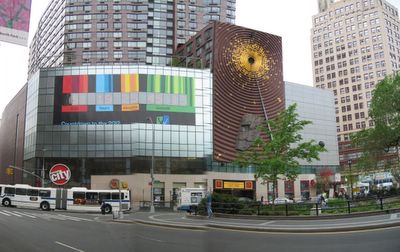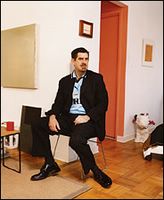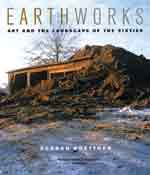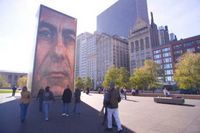Tuesday, May 31, 2005
Two Peeks Last Week
On Thursday, while on duty for the day job, I was part of a team that made a pitch to a new client. This company is a leader in an old-economy industry and has its headquarters in a small Southern city—two attributes that say to me that poster art, if anything, will be hanging on the walls.
When we arrived, we were let into the elevator by a pistol-toting guard. Once on our floor midway up the tower we were ushered into a conference room/holding pen to wait our turn to present. When I wandered down the hallway to find a men’s room, I was shocked when I noticed a signed Richard Diebenkorn woodcut hanging on the wall. It was from an edition of 200, but I know that these works are going for more than the price of a decent car today. I then saw that a card identifying the piece was hanging on the wall next to it—a sure sign of a well curated corporate collection. Surprise!
We were eventually ushered up to the executive floor to do our thing. Coming out of the elevator, I saw that, as I had expected, the floor was decorated in the old boys network style—lots of dark wood, carpets, and leather furniture. What I didn’t expect, though, was the collection of really good ab ex paintings hanging on the walls.
After our pitch was over, I was waiting in the reception area for one of my colleagues to join me. I mentioned to the receptionist that I was impressed with the art hanging around her. Here’s how the conversation went.
Her: “You should take a second look at that little one over there.”I was actually going to tell her that it would fetch around $750,000, but in this market why not ask for an even million?
Me: “I don’t need to. I know what it is.”
Her: “So you know Mark Rothko, then?”
Me: “Sure. Let me ask you a question. Do you have any idea what that's worth?”
Her: “About a million dollars.”
When I returned home, I did a little Internet research. It’s possible to find mention that this company has a corporate art collection. They have even loaned some of their prints for a show at a small regional museum. Nowhere, though, do they make it known exactly how deep the collection is and how good it is. Here’s to hoping that we win the work so that I have an excuse to wander their halls this summer.
The next day, I was home in New York and managed to slip onto the third floor at the Whitney where the summer show Remote Viewing is being installed. The show contains a wall drawing by Julie Mehretu that is in the process of being completed. It was interesting to see the work in progress next to several of her finished paintings propped against the walls waiting to be hung.
I’ll be curious to see how the piece is completed. It looks like a lot of work remains to be done on it before the June 2 opening. And I also wonder who is going to end up suing the museum for ownership of this wall when the show closes and the floor is de-installed.
Monday, May 30, 2005
Walton Unveils Museum Plans
 The Arkansas Times, my new favorite source for art world news and name calling, ran a very interesting piece last week on Alice Walton's plans for her new museum in Bentonville. Here's the lede:
The Arkansas Times, my new favorite source for art world news and name calling, ran a very interesting piece last week on Alice Walton's plans for her new museum in Bentonville. Here's the lede:Wal-Mart fortune heiress Alice Walton unveiled before a throng of well-wishers and Bentonville boosters Monday the plans for her $50 million museum of American art, Crystal Bridges, an architectural wonder that upstaged the revealed works in the collection to hang there.The piece implies that disagreement frequently exists between Walton and her advisor John Wilmerding on acquisition decisions. (Wilmerding, it has been pointed out, both advises Walton and serves as a trustee of the National Gallery of Art which made a competing bid for Asher Durand's Kindred Spirits.)
Walton's acquisitions do, indeed, sound idiosyncratic--the Durand, a Charles Willson Peale portrait of George Washington, a Norman Rockwell entitled Sick Puppy (above right), and work by Winslow Homer, among others. She is also acquiring historical American manuscripts and books. The collection, Wilmerding says, will be closed to work made after the middle of the twentieth century.
Related: Crystal Bridges is shopping for a chief curator and the new Crystal Bridges website, with photos of works in the collection.
Saturday, May 28, 2005
The Art Newspaper on Market Shenanigans
“There’s so much insider trading around these retrospectives”, says London-based dealer Kenny Schachter. “Galleries call their top two or three collectors as soon as they find out and let them in on the deal. In commodities trading, where I used to work, that’s called ‘front-running’ and it’s illegal. I remember when I first stumbled into the art world, I was shocked that it could be run in such an archaic manner.”And
But another top American dealer, likewise coming to Basel, says, “If you make the business transparent it would collapse overnight. I have to have the option to lie to collectors about what’s available or quote them prices 10 times what other people paid. Entire careers are built upon fabrications, like about which shows sold out and at what prices”.Caveat emptor.
Wednesday, May 25, 2005
The Effect of Wasatch Range Snow Melt
Before I even had a chance to publish the post, I got my answer. On Monday Don Hamlin e-mailed me a few photos from his visit to Spiral Jetty last Saturday. I was surprised by what he saw.

Compare this to the photos from my visit last August. What a difference. And I heard that the waterline was significantly farther out from the shoreline by fall. All of that salt flat has now been reclaimed as run off from the snow melt has noticeably raised the level of the Great Salt Lake.
But, on second thought, maybe I shouldn't have been so surprised. This photo, taken at approximately this time last year, shows roughly the same (perhaps slightly lower) water level at the site as we see this year.
It's interesting to see the variability over the course of a year. It makes me wonder if the same thing was happening in the years immediately after Smithson completed the work.
Tuesday, May 24, 2005
A Really Simple Q&A
A: Because American art critics and journalists are too busy navel gazing and bemoaning the current state of the profession to be doing something to make their field more interesting and relevant to the broader public.
Related: MAN's spot-on take on this issue.
Whitney Expansion Plan Approved
A Match Made in Not-Heaven
Here's the telling image (click for an enlargement).

The clock in Kristin Jones and Andrew Ginzel's Metronome at One Union Square has been reprogrammed and is currently counting down the time until the host city for the 2012 Olympics is announced.
Perhaps if New York doesn't get the nod, Metronome will puff out one final, gigantic cloud of steam and will crumble to the sidewalk, freeing up the facade of this building and providing space for a more suitable visual anchor for Park Avenue South.
And if New York does win the bid? It's another seven years of Metronome, a half decade of construction around every corner in the city, and a month of lockdown and police-state presence in 2012 that will make last summer's Republican Convention look like a fire drill.
Monday, May 23, 2005
Airline Haiku
On another long trip some time ago, I got stuck on the tarmac for what seemed like hours. For some reason, I'm not sure why, these haiku bemoaning the life of the frequent flier just happened to fall right out of me:
Extra leg room, none
Economy Plus is full
My gold card, worthless
Stuck on the tarmac
Wheels up at quarter after
It's six twenty now
Tomato juice and
A second bag of pretzels
No food on this flight
And my favorite:
New York - Chicago
By way of Santiago
Think of the miles
When I shared these via e-mail with Mrs. FtF, she shot back with one that tops all of mine:
Where is he this week?
At least there's a cell number
And the cat stays home
Have any, or care to write any, airline haiku of your own? If so, send them my way via email. I'll post any that I receive today.
Back to the visual arts tomorrow. Maybe.
Update: I stand corrected. But the title of the post stands as is.
Friday, May 20, 2005
My Latest Badge of Honor
Some of the criticism has exhibited a certain amount of snobbery about art in the backwoods of Arkansas. On-line art critic and consultant Todd Gibson wrote Friday in fromthefloor.blogspot.com that he’s “afraid that the Durand is heading off to a collection of American art that will be consistently curated to make didactic, patriotic arguments. . . . I’ll bet it’s just a matter of time before reproductions of this work, and the many others Walton has been acquiring, will be available in every Wal-Mart around the country.”Can you belive that? I’ve been called an art snob by the Arkansas Times! There’s one that I will definitely wear with pride.
Seriously, though, if the journalist had understood my reference to Ross Perot and Huntington Hartford, she would have seen that I don’t have it out for Arkansas. Lord knows I’ve traveled to much more remote locales than Bentonville to view art. Heck, I’ll probably find my way there in 2009 to see this collection when the museum opens.
My concern is that, like many private collections assembled by painfully wealthy individuals and eventually opened to the public, this one will be used to make a political statement (for Ross Perot “America rocks,” for Huntington Hartford “MoMA sucks”) and for public relations purposes for the family business (EDS in Perot’s case and A&P for Hartford).
The Walton Family Foundation said, in its announcement about the acquisition of the Durand, that the planned museum will “present perspectives on the flow of America's history and heritage through the eyes of the nation’s most influential artists.” I see a hint in that statement that the art will be used to reinforce notions of American superiority and manifest destiny on a global scale, limiting readings of the works shown and imposing an ideological framework on them by which they should not be constrained.
As for the quip about making the collection available in reproduction through the stores, well, can you imagine them not producing a catalogue and distributing it through Wal-Mart? Come on. There’s no chance that it won’t happen.
Thursday, May 19, 2005
What's New at MoMA?
Earlier this week MAN hinted that MoMA has taken Harvey Shipley Miller's drawing collection. Today The Art Newspaper has MoMA on the record as accepting the gift (as a follow-on to a lede about the purchase of even more real estate on the block). The piece, however, puts an estimate on the collection of approximately $10M, somewhat less than the $75M insured value that Miller was throwing around last summer and fall.
I would still like to have answers to the questions I asked about the gift last September. Chances are, though, that I'll never get them.
Shameless Self-Congratulations
Every so often, though, I find a way to bring these two worlds together. Last November I published something that in retrospect comes across as being just too damn self-righteous. In it, I alluded to the fact that I do some pro bono consulting for nonprofit arts organizations.
I was informed recently, and the announcement was made public yesterday, that I’m being honored by the Arts and Business Council of New York for these efforts. On June 21, I will be receiving this year’s Business Volunteers for the Arts Award as part of their annual Encore Award ceremony. More information, and a listing of this year’s other honorees in the various categories, is available on the organization’s website.
If you’re not familiar with the Arts and Business Council (which recently merged with Americans for the Arts), you should be. Whether you’re a professional with skills to donate or an arts manager facing strategic, marketing, or operational issues, it’s worth a visit to the website to explore their Business Volunteers for the Arts program. This free service is run in 23 cities around the country and has generated over $100M in services for the nonprofit arts community since its inception.
Tickets for the event are available here. If you do attend the ceremony, make a point of stopping by my table to say hello.
Wednesday, May 18, 2005
Architectural Eyewear and Curatorial Facial Hair
Anyone who has even a passing interest in architecture knows that it's impossible to talk about the topic without discussion eventually coming around to the ultra-important subject of architects and their eyewear. The Magazine doesn't let its readers down here.
First up is Deborah Solomon's Q&A with Oregon-based architect Brad Cloepfil who is leading the effort to transform 2 Columbus Circle (the topic of one of the recent Best of From the Floor features):
Actually, wouldn't making bankers more hip be an admirable undertaking?Can we look forward to seeing any lamps or other consumer products [a la Michael Graves] designed by you?
There's a lot of design energy going into eyewear. I'm designing glasses for Amy Sachs, a company based in Portland.
If there's so much creativity going into glasses, how come men and women are now wearing exactly the same frames, those overly small rectangles?
It's as if everyone wants to look like an architect. It must be. But if every banker tries to be hip, it kind of ruins hipness.
 The Magazine follows with a visit to the Greenwich Village studio apartment of MoMA architecture and design curator Terry Riley. It's nice to see that the ultimate taste-maker lives in the same boring, parquet-floored urban box that the rest of us do. And it's interesting to note that he has replaced his oven with a microwave. You do get what this means, don't you? When he's not eating at a benefit somewhere, Riley is warming up a Lean Cuisine at home by himself. You've got to wonder how many who got that e-mail are actually his nearest and dearest if he's never cooking dinner for anyone at home. But I digress. The zinger of the piece is this:
The Magazine follows with a visit to the Greenwich Village studio apartment of MoMA architecture and design curator Terry Riley. It's nice to see that the ultimate taste-maker lives in the same boring, parquet-floored urban box that the rest of us do. And it's interesting to note that he has replaced his oven with a microwave. You do get what this means, don't you? When he's not eating at a benefit somewhere, Riley is warming up a Lean Cuisine at home by himself. You've got to wonder how many who got that e-mail are actually his nearest and dearest if he's never cooking dinner for anyone at home. But I digress. The zinger of the piece is this:Ditto for curators and facial hair, Terry. Ditto for the facial hair.Pet peeve about architects:
It is a character flaw of many architects that they try to express themselves through their eyewear. I strongly urge them to work on this.
Tuesday, May 17, 2005
The Muster
It was the strangest, craziest, most polyphonic (and most fun) art event I've been to in ages.
Yesterday's Times piece on the event gives a good sense of what the afternoon was like. Each of the fifty participating artists or groups defined the cause they were fighting for. This pretty much sums up the event and the cognitive space that visitors were moved into as they entered the bivouac field:
Across the way, students from the Rhode Island School of Design, under the direction of Liz Collins, a professor, put up a tent filled with knitting machines, where they cranked out a huge abstract red-white-and-blue cotton banner during the afternoon. Julia Bryan-Wilson, another professor, said that earlier in the day, the knitters were approached by a man who had come to the island thinking there was going to be a real Civil War re-enactment. "He was just really confused," she said. "When I said that we were fighting for a sovereign nation of knitters, he didn't like that at all."The afternoon included a special "Declaration of Causes," where Smith called the roll and asked each participant, "What are you fighting for?" The answers ranged from "the right to be scared," to "the right to sing sentimental songs in full," to "a return to chivalrous battle techniques and the preservation of historical methods of warfare," to "peace and cheaper lift tickets," to "sequined religious figures."
This muster may not have been the "weekend of alcohol fueled lesbianity" that Smith's last one was, but it was memorable nonetheless. It also started discussion among the family unit about what causes we are fighting for. Mrs. FtF and her blistered feet are fighting for cute but comfortable shoes. The kid is fighting for dry diapers. As for me, I'm fighting for an end to the tyranny of sleep deprivation imposed by babies.
Friday, May 13, 2005
Kindred Spirits Sold to Wal-Mart
 Carol Vogel reports in today's New York Times that the New York Public Library has sold Asher Durand's iconic Kindred Spirits to Alice Walton, heiress to the Wal-Mart fortune, for more than $35M.
Carol Vogel reports in today's New York Times that the New York Public Library has sold Asher Durand's iconic Kindred Spirits to Alice Walton, heiress to the Wal-Mart fortune, for more than $35M.In an attempt to keep the work in the collection of a major, east-coast museum, the Met and the National Gallery of Art placed a combined bid for the painting. Even though the NYPL had offered preferred pricing terms to New York museums interested in the work, Walton's offer was too sweet to pass up.
According to Vogel's report, Walton plans to exhibit the painting in a museum scheduled to open in 2009 that her family foundation is building in Bentonville, Arkansas--the home of Wal-Mart. Vogel quotes a statement released by the foundation as saying that the museum will "present perspectives on the flow of America's history and heritage through the eyes of the nation's most influential artists."
I can picture the results already: Ross Perot's collection of Americana meets the long-defunct Huntington Hartford Museum of Art. I'm afraid that the Durand is heading off to a collection of American art that will be consistently curated to make didactic, patriotic arguments. The NYPL attempts to put a positive spin on the sale by claiming that they are happy the painting will be staying in America and will be displayed in a museum. Unfortunately, Durand's painting deserved better than this.
On the upside, though, I'll bet it's just a matter of time before reproductions of this work, and the many others Walton has been acquiring, will be available in every Wal-Mart around the country. Wait, maybe that isn't an upside.
Related: JL of Modern Kicks isn't as upset as I am.
Thursday, May 12, 2005
What's Not Going On
I'm on the road, all over the place for the next few weeks, on a plane almost every day.
I'm so scattered right now that I can't keep my art viewing schedule straight. I've had the Sotheby's catalogues sitting on the credenza in my living room for several weeks, but I've been too busy on the days that I've been home to open them up even to browse. For some reason, I thought previews were this weekend and the auctions were next week. Wasn't I surprised, then, to see auction reports start appearing in the Times and on Artnet while I was sitting out in suburban Chicago this week. Flaked on that one, I did. I so could have fit the previews in last Sunday afternoon. Idiot.
I'll try to see a few things this weekend and put a couple posts in the bank for next week. Mrs. FtF is already angling for me to sneak her into the Cooper-Hewitt on Saturday to see an exhibition of high performance fabrics or something which is of no interest to me. But if I go I'll be in the neighborhood and will finally be able to see the Daniel Buren installation at the Guggenheim.
Tuesday, May 10, 2005
Drawing on What’s Always Out There
Culture has become saturated with sexually explicit images, the curators argue, thanks in no small part to the growth of the Internet. Advertising, television, and film have also played a role. At the same time that graphic images have become available on demand through multiple channels, artists have returned to depicting the human figure. This exhibition presents the results of artists filtering the explicit images swirling around them through the process of drawing. The results range from the pornographic to the conceptual to the gut-bustingly funny.
Tracy Nakayama contributes some of the most aggressive images in the show. Her watercolor reproductions of pornographic photographs leave nothing to the imagination. The pinkish-orange palette and her deft handling of the medium, though, seduce the viewer into ignoring the figures engaged in sexual acts. Her technical proficiency makes it difficult to read the works as something other than abstractions. The graphic subject matter, though, eventually yanks one back from reverting to a pure formalist reading. The tension created between form and content provides a sticking power for her work that the source photographs could never have.
Kim McCarty creates a similar tension in her lush watercolors. McCarty works quickly on wet paper, allowing the pigment to seep into and bleed through its support. Her process leads to slippery color fields that ask to be read as abstractions. It’s impossible, though, to step back and not notice that you are gazing at portraits of children posed and presented as sexualized objects. Viewers who are drawn into the works because of their color and surface become implicated as voyeurs when they realize they are facing children in socially unacceptable poses who are staring back at them with a look of accusation.
Not all the work in this show is so serious or troubling. Stephen Andrews has contributed an animated video entitled QuickTime Interruptus that draws belly laughs from almost all viewers. Surfing the web for porn and being overwhelmed by pop-up ads has never been this funny.
No exhibition of erotic drawing would be complete without a selection of adolescent masturbatory fantasy doodles, and America’s official dirty old man, R. Crumb, obliges with several pieces. Lecherous, humorous, aggressive, and totally toothless, Crumb’s work serves as a foil for some of the more creative and interesting pieces in the show—work by younger female artists who are starting to make their marks in the art world.
Chloe Piene is represented in this show by a drawing entitled Thirty Years Old. In the series from which this work is drawn (three other pieces were shown in the last Whitney Biennial) Piene presents single women masturbating. Caught at the moment of le petite morte their bodies are captured in the act of decomposing. Skin slides away; skeleton replaces flesh. Composed of unsteady, shaky lines on vellum, these drawings exist at the intersection of the erotic and horror—the space that every teen slasher pic wants to fill but never does as well as this.
Danica Phelps includes four drawings that document her physical relationship with her partner. Originally known for creating works that illustrate the meticulous accounting she keeps of all her financial transactions, Phelps created these works after she left her husband for a woman. Making love to her new lesbian partner becomes another transaction for her to document, and she does so here, mixing together on each page purchases made, errands run, and cash spent with the times she made love to the new woman in her life.
The show also includes work that leans toward the conceptual. Alice Attie draws text from the novels of James Joyce and reproduces it in miniscule size to form lines and patterns. Molly Bloom’s soliloquy from Ulysses, for example, runs around and around to create a target with a bulls eye of empty space at the center. Visitors are encouraged to use a magnifying glass to read the text.
Far from being titillating, this show provokes discussion on the role of the explicit image in contemporary culture. Images of desire are being endlessly circulated today for reasons of commerce (sex sells, after all) rather than as erotica or pornography as they have in the past. The exhibition demonstrates the various ways the new explicit is being picked up and used to fuel artistic practice. The results are diverse, and the show convinces that the topic is worth exploring further.
“Contemporary Erotic Drawing” is on view through August 7 at The Aldrich Contemporary Art Museum in Ridgefield, CT.
Monday, May 09, 2005
The Show I Would Curate, If I Curated
Off the top of my head, here are some of the artists (in alphabetical order) who I would include in the show:
- Amy Cutler
- Peregrine Honig
- Kim McCarty
- Amy Morken
- Tracy Nakayama
- Danica Phelps
- Chloe Piene
Friday, May 06, 2005
How Smithson Became Smithson
 I don't do book reviews on From the Floor. Writing about writing about art is one step too far removed from the good stuff. But I've been working through a book recently that has impressed me enough to mention it here.
I don't do book reviews on From the Floor. Writing about writing about art is one step too far removed from the good stuff. But I've been working through a book recently that has impressed me enough to mention it here.The third chapter ("Toward Heterotopias") of Suzaan Boettger's Earthworks: Art and the Landscape of the Sixties does an exceptional job of telling the story about how Robert Smithson crystallized (pun fully intended) the ideas that became central to his practice.
It's not often that one gets a picture as clear as this of how an artist solidifies a theoretical framework. For devoted fans of Earthworks, or New Yorkers preparing for the Smithson exhibition planned for the Whitney this summer, Boettger's book is worth a read.
And, as an added bonus, the book is filled with old New Yorker cartoons poking fun at the movement and photos of hirsute critics from the 1970s jetting around on Cornell University's private plane.
Thursday, May 05, 2005
Elsewhere Today
I believe we’re currently experiencing a bubble in the contemporary art market that rivals the bubble in technology stocks seen in the late ’90s. When the bubble bursts—and it eventually will—the market for contemporary art will look very different than it does today. Emerging visual artists, as a result, will need to use new strategies for marketing their work to survive the change in environment.Read the whole piece here.
And while you're at it, you really ought to subscribe to NYFA Current if you don't already. The price (free) is right, and the content is always compelling.
Wednesday, May 04, 2005
Your Very Own Superflat Museum
 Walking down St. Marks Place last weekend, I happened to glance in the window of a Japanese toy store. To my surprise, I saw a whole collection of miniature Takashi Murakami pieces sitting there for the taking.
Walking down St. Marks Place last weekend, I happened to glance in the window of a Japanese toy store. To my surprise, I saw a whole collection of miniature Takashi Murakami pieces sitting there for the taking.Scaled to the size of pocket figurines, the ten works in "Takashi Murakami's Superflat Museum Set" present his biggest hits--from Miss Ko2 to Mr. DOB to the happy mushrooms--done in a smaller size.
The store I found was selling the pieces individually for prices ranging from $10 to $20. With a little web searching, though, I found another outlet that is retailing the whole set of ten for an even $100.
But I should have known to look on eBay first. There's an on-line store there that has a category devoted to these little figures.
Tuesday, May 03, 2005
The Park of the Century, But Which One?
 The problem with Millennium Park, though, is that the whole never makes an impression that equals the sum of its parts due to its anachronistic site plan.
The problem with Millennium Park, though, is that the whole never makes an impression that equals the sum of its parts due to its anachronistic site plan.Maybe I caught the park at a bad time. April is the cruelest month for landscape architecture, after all. But Millennium Park was not shining last week.
Kapoor’s 35-foot-high stainless steel sculpture, Cloud Gate, is currently covered with an enclosed tent and will remain that way for at least another month. The piece needs additional welding and polishing, one of the dozen or so rent-a-cops walking the grounds told me. (Why are there so many private security people guarding the park, I wondered. If the park needs that much security presence, maybe it’s not the place to stroll on a nice evening.)
 Half of Juame Plensa’s glass brick and video Crown Fountain was also roped off for repairs. The video was running, but the water was turned off. Gehry’s Jay Pritzker Pavilion was intact. But I was surprised, when I approached the park from its north side on Randolph Street, to see that no attempt had been made to finish the backside of Gehry’s signature swooping stainless steel panels. From the north, the structure gives the impression of the rear side of a Hollywood sound stage—all façade propped up with naked metal supports.
Half of Juame Plensa’s glass brick and video Crown Fountain was also roped off for repairs. The video was running, but the water was turned off. Gehry’s Jay Pritzker Pavilion was intact. But I was surprised, when I approached the park from its north side on Randolph Street, to see that no attempt had been made to finish the backside of Gehry’s signature swooping stainless steel panels. From the north, the structure gives the impression of the rear side of a Hollywood sound stage—all façade propped up with naked metal supports.But what disappointed me most about the park was the built and landscaped environment that ties these pieces together. The park has been constructed around pieces by Gehry, Kapoor, and Plensa—three artists whose work is as contemporary, as of the moment, as possible. The rest of the park, though, has been lifted straight from Fredrick Law Olmstead’s playbook: long, straight promenades, heavy stone balustrades guarding the grand staircases and walkways, and clichéd plantings.
Being whipsawed back and forth between the past and the present as I wandered the walkways, I couldn’t quite place why I wasn’t as impressed with the park as I had expected to be. Then I made the realization. These three signature works of early twenty-first century art and design have been linked together with a site plan that’s wholly derivative of a nineteenth-century style. The juxtaposition doesn’t benefit either the park or the works.
Gehry, Kapoor, and Plensa deserved better. Chicago deserved better. Millennium Park just might be one of the best millennium projects in the world. (Given the London Eye and Millennium Dome as competition, though, that’s not saying much.) But it’s not one of the best parks of the century. Not this century, or the last, or even the one before.
Monday, May 02, 2005
Impressions from the Art Institute of Chicago
- The new American galleries installation freshens up some of the hangings and puts on view a good deal of new work from the Terra Foundation, but it doesn't present any new readings of the subject. The galleries are hung to make the canonical art historical distinctions--colonial portraits, Hudson River School, late-nineteenth-century European-trained portraitists, Ash Can School, American modernists, etc. The eighteenth- and nineteeth-century works are hung amid pieces from the museum's design collection.
- It is nice to see, though, a serious treatment of American visual modernism. Only the Whitney does it better than the Art Institute does.
- Aside from Grant Wood's American Gothic and Edward Hopper's Nighthawks the collection is lacking exceptional pieces completed since 1930. The collection of mid- and late-nineteenth-century American works, though, is world class.
- It would make great sense for Chicago to have an especially strong collection of American Regionalist works from the 1930s, but that's not the case. I'm not sure why.
- No Ab Ex work? How can that be? Did I just miss that gallery somehow?
- On my last visit to the Art Institute, a few years ago, I was especially impressed with the installation in their contemporary galleries. Not this time around, though. In one gallery a mediocre Rosenquist hangs with two bad Lichtensteins, a large Warhol Mao (backed by Mao wallpaper), and a fabulous black and white Gerhard Richter from the 1960s. Richter in with the American Pop artists? Really? I get what the curator was trying to say, but it so doesn't work.
- The Art Institute owns what could be Glenn Ligon's best work ever--a massive piece from his Stranger in the Village series. I was disappointed to see that it's not currently on view. It's better than anything else they have up right now in their contemporary galleries.
- I was pleasantly surprised by a temporary exhibition that is on display through this week. In Sight: Contemporary Dutch Photography from the Collection of the Stedelijk Museum, Amsterdam is worth seeing if you're in Chicago and anywhere near the Loop.